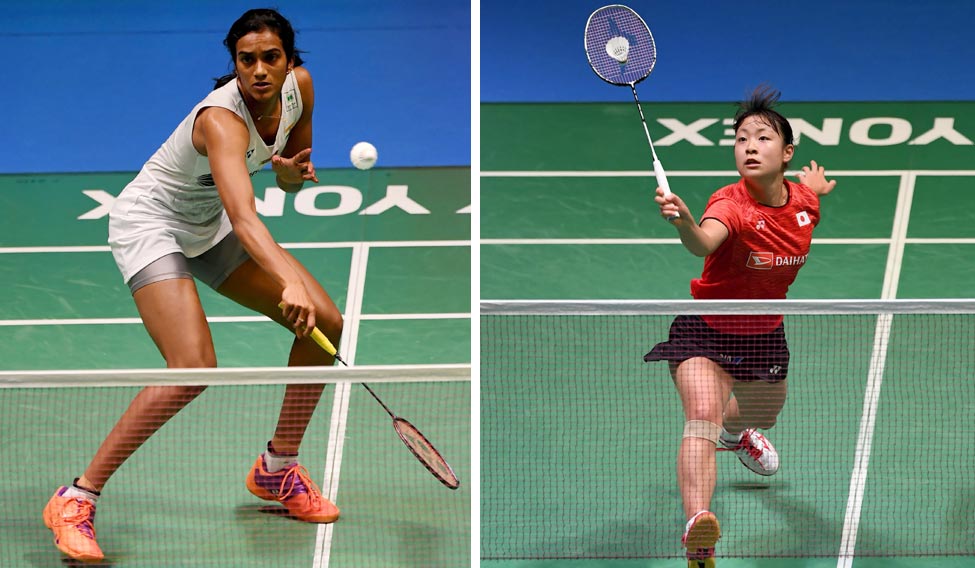Very little separates Pusarla V. Sindhu and Nozomi Okuhara when the two 22-year-olds (Okuhara is four months older) meet on court. The close contests they have fought out in recent weeks have left the audience enthralled as they competed fiercely, unwilling to yield a single point. In August-September, the two met thrice. The first two encounters, at the World Championships in Glasgow and the Korea Open Superseries in Seoul, were both three-game thrillers.
The final of world championship went down in history as “one of the all time great contests”. The BWF website termed the match “gold standard”. It lasted 110 minutes—the second longest women’s singles match in badminton history. At the end of the longest rally of the match—an incredible 73 strokes—the audience rose to their feet in appreciation. (For the record, Okuhara was also part of the longest women’s singles match ever. A 111-minute quarterfinal at the 2015 Malaysia Open Superseries Premier that she lost to China’s Wang Shixian.)
On September 17, at the Korea Open final, Sindhu had her revenge by beating Okuhara in 83 minutes. But, when the two met in the second round of the Japan Open Superseries on September 21, the match did not live up to expectations and Sindhu lost in straight games. The head-to-head record at present is 5-4 in Okuhara’s favour. However, in 2017, they have played each other four times and hold two victories each. Six of their last eight matches have gone into the third game.
Okuhara is known for playing long rallies at a fast pace. Sindhu is famous for her ability to retrieve the shuttle and her back-of-court game. The pint-sized Okuhara is 5’1” compared to Sindhu’s 5’9”-frame. The Indian is currently ranked second in the BWF World Rankings while Okuhara is ranked eighth. Okuhara, however, is yet to win a medal at the Olympics while Sindhu won silver at Rio 2016.
Even as their rivalry becomes the toast of the badminton world, Sindhu, who was recently recommended for the Padma Bhushan—India’s third highest civilian award—by the sports ministry, said that she hopes to be world number one soon. She took a day’s break before returning to her training base—the Sports Authority of India-Gopichand National Badminton Academy in Gachibowli, Hyderabad—and spoke to THE WEEK about her face-offs with Okuhara and the lessons she has learnt. Edited excerpts:

How would you describe the last three weeks? You met Nozomi Okuhara thrice.
[Laughs] It’s been good. Overall I would say. Reaching the world championship finals. It was anybody’s match that one. Then meeting her yet again in the Korea Open finals; that too was a long and good match. Beating her in the finals was sweet revenge for me. Then I met her again in Japan. I didn’t play my game the way I should have.
You have a great rivalry with Olympic champion Carolina Marin and now with world champion Okuhara. Who is the tougher opponent?
I wouldn’t like to compare. Both are completely different players. Also the Olympics and World Championships are entirely different competitions. The environment, too, is different. Marin is a more attacking player while Okuhara is a rally player—she does not yield a point easily.
It is being described as an epic match, the world championship final.
Yes, it feels nice to be part of an epic match. It was definitely one of the longest matches I have ever played. Some of the rallies were really long—one was a 73-shot rally!
What did you say to each other after that match?
Both of us were really tired. It was physically and mentally tiring. It was anybody’s match at 20-20 in the third game. At the end of it, I guess it was simply her day. I don’t think I made any mistakes. But I ended up on the losing side.
How did you prepare for the Korean Open final?
Looking at the draw, I expected her to make it to the finals. I concentrated on my game. I was prepared for yet another long match. It was almost identical to the world championship final. It was 17-16 then 19-17. There was that one point at 17-18 which was really long.
What did you learn about badminton and yourself from these matches?
I have definitely learnt a lot from these last three matches. Most importantly, winning and losing are part of life. All you can do is give your best. The gap between all top badminton players is so less today, you have to be prepared for anything!
So how would you describe the friendship and rivalry that is brewing between the top ladies of world badminton—Sindhu, Marin and Okuhara?
[Laughs] Marin tweeted a pic of ours ahead of the Japan Open. We are friends off court, but on court the rivalry is fierce.
What did your coaches—Gopichand and Mulyo Handoyo—tell you after the world championship match?
Both said that there was little they could say after that match. One player had to win, it was evenly matched. They said ‘you played really well’.







